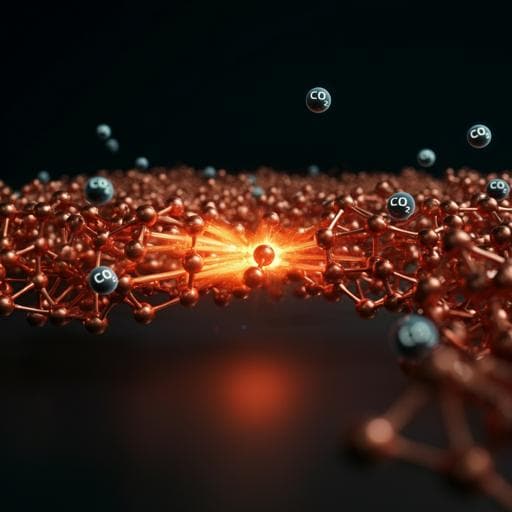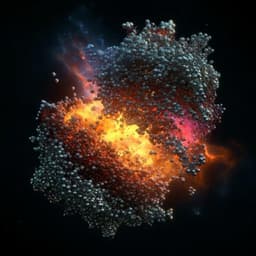
Chemistry
Atomic-scale surface restructuring of copper electrodes under CO₂ electroreduction conditions
R. Amirbeigiarab, J. Tian, et al.
This groundbreaking research conducted by Reihaneh Amirbeigiarab, Jing Tian, Antonia Herzog, Canrong Qiu, Arno Bergmann, Beatriz Roldan Cuenya, and Olaf M. Magnussen explores how potentiodynamic methods can induce structural changes in Cu catalysts, enhancing their selectivity for electrochemical CO₂ reduction. The findings reveal the spontaneous formation of low-coordinated Cu surface species, paving the way for innovative CO₂RR site regeneration.
~3 min • Beginner • English
Introduction
The electrochemical reduction of CO₂ (CO₂RR) on copper is attractive for storing renewable energy as fuels and chemicals, yet suffers from limited energy efficiency and selectivity. Catalyst performance depends sensitively on surface structure and nanoscale morphology under operating conditions. Recent potentiodynamic approaches, particularly pulsing between oxidation and reduction, can create active states that steer selectivity toward multicarbon products, but require polarity reversals that are impractical for scale-up and it is unclear whether purely cathodic pulsing can achieve similar benefits. Fundamentally, copper surfaces exhibit high mobility and restructure under various conditions, suggesting that dynamically formed low-coordinated sites could influence CO₂RR pathways. This study asks whether, under neutral carbonate electrolyte and CO₂RR-relevant potentials, Cu surfaces spontaneously generate low-coordinated species without prior oxidation, how this restructuring proceeds at the atomic scale, and how it affects the molecular adlayer and potential strategies for catalyst activation.
Literature Review
Prior work shows Cu surfaces reconstruct under hydrogen evolution and in alkaline solutions: hydrogen-induced restructuring of Cu(100)/(111) at low pH observed by in situ STM and explained by theory; Cu(111) reconstructs near the potential of zero charge in alkaline media. Under CO gas, Cu(111) and Cu(100) undergo CO-induced nanoclustering with clusters of 0.5–1.5 nm (triangular/hexagonal on Cu(111)) and square/1D clusters on Cu(100) at sub-mbar to tens of mbar CO. In alkaline electrolyte during CO electro-oxidation, similar CO-induced cluster formation on Cu(111) was largely reversible, with low-coordinated species important for CO oxidation. Under CO₂RR in bicarbonate (pH ~7), in situ/operando studies reported larger-scale morphological changes: polycrystalline Cu reconstructs toward Cu(100) facets with potential; potential and time yield Cu nanocuboids; AFM revealed roughening, oxide-reduction-driven multilayer Cu islands, and potential-dependent step density changes. Vibrational spectroscopy provided indirect evidence for restructuring and proposed reversible CO-induced cluster formation at ~−0.6 V vs RHE at high CO coverage. However, many studies involved unavoidable initial oxidation, not starting from atomically flat Cu(100), and direct atomic-scale evidence of restructuring under CO₂RR remained limited.
Methodology
The study combined in situ STM, in situ surface X-ray diffraction (SXRD), and in situ surface-enhanced Raman spectroscopy (SERS) on Cu(100) in CO₂-saturated 0.1 M KHCO₃. STM/SXRD used electropolished single-crystal Cu(100) with procedures to rigorously avoid initial oxidation: the sample was immersed in 0.1 M H₂SO₄ at controlled potential (0.05–0.15 V) and then electrolyte-exchanged under potential control to 0.1 M KHCO₃. STM (electrochemical cell under CO₂, ~100 µl volume, 1–2 mm electrolyte thickness) operated in constant current mode (0.05–0.7 nA, bias −0.09 to −0.7 V), imaging during stepwise potential changes from positive of 0 V to negative potentials where CO₂RR commences. SXRD was performed at PETRA III (P23 beamline, 22.5 keV, 2° incidence) using a PEEK flow cell with continuous CO₂-saturated KHCO₃ exchange (5 µl s⁻¹) to mitigate radiolysis and bubble effects. Full CTRs [(111), (200), (220), (310)] were collected at 0.0, −0.1, −0.2, −0.3, −0.4, −0.7, and −1.1 V (vs Ag/AgCl converted to RHE); potential-dependent scattered intensity at fixed reciprocal space points [(2,0,1.6) and (1,1,1.5)] was monitored during cyclic voltammetry (5 mV s⁻¹) to capture dynamics. CTR datasets (~1 h each) were quantitatively fitted with SuPerRod/DaFy using a model comprising surface adatom–vacancy defect pairs (Cu atoms moved from surface layer to atop lattice sites) and vertical relaxations of interlayer spacings d₁₂ and d₂₃; inclusion of weakly scattering adsorbates (CO, CO₂, H₂O) was tested but had minor influence. SERS used roughened Cu(100) prepared by electropolishing and oxidation–reduction cycling in CO₂-saturated 0.1 M KHCO₃ to obtain Cu₂O-free, SERS-active electrodes. Spectra (HeNe 633 nm, 1,800 lines mm⁻¹ grating, 10 s acquisition) were recorded stepwise during cathodic scans from +0.25 V down to −0.58 V and back, allowing steady state (5–10 min) at each step; bands were assigned to (bi)carbonate, carboxylate intermediates, and CO (bridge/atop), with quantitative band fitting conducted in Octave.
Key Findings
- In situ STM revealed CO-induced formation of nanoscale Cu clusters on atomically flat Cu(100) terraces starting near −0.22 V vs RHE. Cluster density increased by −0.27 V and clusters disappeared upon returning to positive potentials (0.1 V), demonstrating reversibility of clustering; however, surface defects persisted.
- Cluster metrics: majority with diameters ≤1.5 nm and apparent height of ≈1 Cu monolayer; a minority up to ~5 nm diameter and ≤0.4 nm height. Shallow terrace depressions (vacancy-related) appeared concurrently with clusters, with apparent depths ~0.03–0.1 nm.
- Coverage estimates (STM grain analysis): cluster coverage ~4%; depressions after cluster dissolution ~6%, consistent with formation of adatom–vacancy pairs.
- In situ SXRD CTR fits showed the surface density of adatom–vacancy defects increases markedly at potentials ≤−0.2 V (aligned with STM cluster onset) by about 4% coverage, remains approximately constant from −0.2 to −1.1 V (clusters present under CO₂RR), and decreases only slightly when potential is returned to 0 V, indicating dispersion into adatoms that remain on the surface.
- Vertical lattice expansion of the top Cu layer (d₁₂) is decoupled from clustering: ~1% in the double layer region, increasing below ~−0.4 V up to ~2.5% at −0.7 V, then dropping to ~1% at −1.1 V. Upon reversing the potential, the expansion behavior is reversible and can reach up to ~3.4% before decreasing, consistent with adsorbate-induced effects.
- Potential-dependent SXRD intensities at (1,1,1.5) and (2,0,1.6) during CV corroborated two distinct transitions: a smooth change around −0.1 to −0.3 V (defect formation) and a sharper change near −0.4 V (vertical expansion/adsorbate change), both largely constant at more negative potentials.
- Molecular-scale STM showed that initial ordered (√2×6√2)R45° carbonate adlayer at 0.1 V becomes disordered upon cluster formation at −0.27 V; after returning to 0.1 V, clusters vanish but the ordered adlayer does not re-form, leaving a stable, disordered adlayer with higher vertical modulation and local pits/protrusions, indicative of persistent adatoms/vacancies disrupting long-range order.
- In situ SERS identified adsorbate evolution: strong (bi)carbonate and bidentate carbonate bands (e.g., 360, 1,050–1,072, and 1,540 cm⁻¹) dominate at positive potentials and diminish below −0.05 V; carboxylate/carboxy bands (∼1,390 and 1,610 cm⁻¹) appear at −0.05 V, vanish below −0.33 V, and reappear on reverse scans—irreversibly retained at positive potentials. CO adsorption emerges from −0.24 V with Cu–CO rotation (~280 cm⁻¹), stretching (~360 cm⁻¹), and broad 1,900–2,100 cm⁻¹ bands; CO evolves from low-coverage bridge to atop configurations with higher coverage at more negative potentials. A broad ∼2,900 cm⁻¹ band (C–H containing species) appears below −0.04 V and persists on reverse scans.
- Mechanistic picture: CO formation at ~−0.2 V triggers extraction of Cu atoms from terraces to form adatoms and vacancy islands that coalesce into nanoclusters; the process is kinetically limited (low cluster density) due to co-adsorbates ((bi)carbonate/carboxylates) and interfacial electric fields inhibiting adatom formation/mobility. On increasing potential above −0.2 V, clusters disperse into Cu adatoms that remain trapped by the molecular adlayer, preventing recombination with vacancies and reordering of carbonate phases.
- Implications: Persisting low-coordinated Cu sites (adatoms, vacancy edges) span the full CO₂RR potential range and likely provide preferential binding sites influencing activity/selectivity toward multicarbon products; potentiodynamic protocols confined to cathodic potentials could regenerate/augment active defect ensembles.
Discussion
The study demonstrates that under neutral carbonate electrolyte, the onset of CO formation on Cu(100) inherently produces low-coordinated Cu surface species via CO-induced nanoclustering originating from terrace atom extraction. This restructuring begins around 200–220 mV positive of commonly cited values and proceeds rapidly to a kinetically limited, low-density steady state, reconciling spectroscopic observations of CO coverage increases with only modest morphological roughening. The persistence of adatoms and vacancies after clusters dissolve at more positive potentials explains the irreversible molecular adlayer disordering and the loss of long-range carbonate order, which modifies the interfacial environment and stabilizes reaction intermediates. These low-coordinated sites are mechanistically relevant: theory and prior experiments indicate enhanced CO₂ activation and altered C–C coupling propensities at undercoordinated Cu, aligning with observed potential-dependent changes in CO adsorption geometry and vertical lattice expansion tied to adsorbate loading. The findings rationalize how catalyst self-activation can occur at low reduction currents, seeding active ensembles that endure throughout the CO₂RR window. Moreover, because the cluster density is governed by kinetics, targeted potential excursions within the cathodic regime should adjust the population of active low-coordinated sites without anodic oxidation, offering a practical route for selectivity control in scalable electrolyzers.
Conclusion
In situ STM, SXRD, and SERS reveal that CO produced near the onset of CO₂ electroreduction on Cu(100) drives rapid formation of Cu nanoclusters and adatom–vacancy defects in a narrow potential window around −0.2 V vs RHE. While clusters dissolve upon returning to positive potentials, adatoms persist, irreversibly disrupting the ordered carbonate adlayer and yielding a disordered, mixed molecular–defect adlayer. SXRD confirms a sustained population of surface defects through the entire CO₂RR range, while vertical lattice expansion reflects adsorbate-induced structural changes at more negative potentials. These self-formed, low-coordinated Cu sites likely underpin key CO₂RR pathways and selectivity trends, providing a microscopic basis for catalyst self-activation under operando conditions. Future research should quantify the relation between defect density and product selectivity under controlled potentiodynamic protocols restricted to cathodic potentials, extend atomic-scale characterization to polycrystalline and nanoparticle catalysts, and integrate potential- and field-dependent adatom formation into ab initio models to guide operando-active site engineering.
Limitations
STM imaging was unstable at the most negative CO₂RR potentials due to gas evolution, limiting direct atomic-scale observations in that regime. SXRD CTR datasets required ~1 h per potential, reflecting steady-state behavior and averaging over transient dynamics; bubble formation caused up to ~15% X-ray intensity fluctuations. The CTR structural model, while capturing key features via adatom–vacancy defects and interlayer relaxations, treated weakly scattering adsorbates approximately. SERS employed roughened Cu(100) and oxide-reduction pretreatment to achieve enhancement, which differs from atomically flat single crystals and may introduce surface features not present in STM/SXRD samples. Potential referencing differences between setups and the necessity of continuous electrolyte exchange may also influence interfacial conditions.
Related Publications
Explore these studies to deepen your understanding of the subject.







